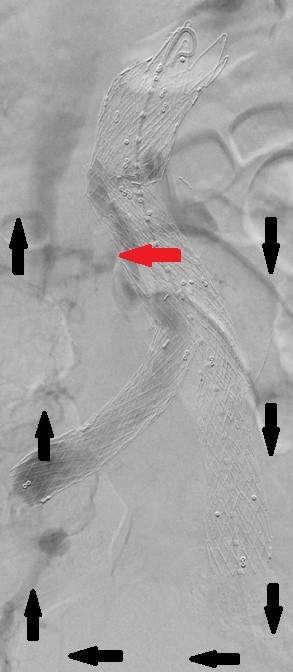Aortocaval Fistula with Associated Rupture Due to a Type III Endoleak Requiring Eventual Iliac Limb Coiling and Femoral Artery Ligation a Decade after Endovascular Repair of an Abdominal Aortic Aneurysm: A Case Report and Literature Review
David J. Nye, DO, Gregory Clabeaux, DO.
Sisters of Charity Hospital, Buffalo, NY, USA.
Demographics
Aortocaval fistulas (ACF) occur in less than 1% of all abdominal aortic aneurysms (AAA). In ruptured AAAs, however, ACFs can occur up to 6% of the time.
History
A 75-year-old male with a history of chronic kidney disease and repair of an abdominal aortic aneurysm 11 years ago with an Aneurx (Medtronic) graft presented with abdominal pain and bilateral leg swelling. A CT scan in the ED revealed a well-positioned infrarenal aortic stent graft in a 7.4cm AAA and contrast extravasation within the sac. He had been lost to follow up.
Plan
An aortogram revealed a type III endoleak and an ACF that was not identified on initial CT scan. Attempts at component overlap and re-lining the entire left limb were unsuccessful. Therefore, a left aorto-uni-iliac stent graft and right iliac limb occluder plug (Talent) were placed in the left iliac limb and right iliac limbs, respectively. A successful left to right femoral-femoral bypass was performed to restore blood flow to the right lower extremity. Continued abdominal pain prompted a return to the operating room for an angiogram which showed flow across the left to right femoral-femoral bypass then retrograde flow up the right iliac limb, into the sac and through the aortocaval fistula (Fig 1.) After coil placements in the right iliac limb and ligation of the right common femoral artery, a post op ultrasound showed no further endoleaks.
Discussion
The AneuRx (Medtronic) aortic stent graft has been known to cause type III endoleaks due to metal ring fractures. There have been several case reports describing ACFs after previous EVAR due to type II endoleaks but we have found only one other ACF after EVAR due to a type III endoleak. In that case report they were able to re-line the separated iliac limb and extender cuff. Our efforts were much more substantial and required a left aorto-uni-iliac graft, a right iliac occluder plug, a left to right femoral to femoral bypass, right iliac coils, and a right common femoral artery ligation to exclude the type III leak and aortocaval fistula. 
Back to 2019 ePosters
